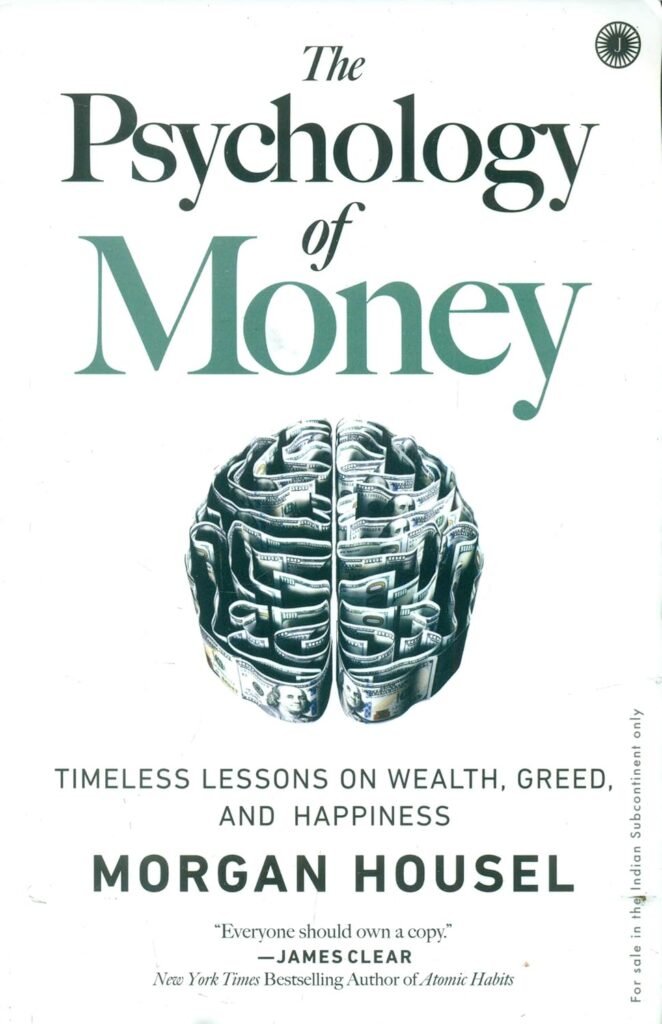The Psychology of Money: A Timeless Guide to Wealth and Happiness

Money is one of life’s most significant influences, impacting our decisions, lifestyles, and even our happiness. Yet, as Morgan Housel’s bestselling book The Psychology of Money reveals, managing money isn’t just about numbers and spreadsheets—it’s deeply tied to human behavior and psychology.
In this insightful book, Housel delivers timeless lessons on wealth, greed, and happiness, offering a fresh perspective on personal finance. Whether you’re an experienced investor or someone simply looking to make better money decisions, this book is packed with valuable insights.
Key Themes and Insights
1. Behavior Matters More Than Knowledge
One of the central ideas in The Psychology of Money is that doing well with money isn’t necessarily about what you know. It’s about how you behave. Even highly intelligent people can make poor financial decisions because behavior is shaped by personal history, emotions, and external influences. As Housel points out, financial decisions are rarely made on a spreadsheet—they’re made at the dinner table, in meeting rooms, and in the context of our unique life experiences.
2. The Power of Perspective
The book emphasizes that everyone’s approach to money is influenced by their upbringing, past experiences, and worldview. For example, someone who grew up during an economic recession may view risk and savings very differently from someone who experienced a booming economy. Understanding these differences can help us make more rational and empathetic financial choices.
3. 19 Short Stories That Resonate
Housel uses 19 engaging stories to explore the complex ways people think about money. Each story serves as a lesson in how to navigate the emotional and psychological challenges of wealth management. Topics include:
- The value of patience in investing.
- The pitfalls of greed and overconfidence.
- Why financial freedom matters more than financial success.
These stories are not only relatable but also actionable, helping readers rethink their own money habits and strategies.
4. Emotional Intelligence in Money Management
Housel challenges the traditional notion that money management is purely mathematical. He argues that emotions like fear, greed, and pride often dictate financial decisions. By recognizing these emotional triggers, readers can develop healthier relationships with money and avoid common pitfalls.
Why This Book Stands Out
Housel’s writing is refreshingly straightforward and free of complex jargon. He makes financial concepts accessible to everyone, blending storytelling with actionable advice. This approach sets The Psychology of Money apart from other personal finance books that often rely heavily on technical details.
Moreover, the book’s focus on happiness and fulfillment rather than just accumulating wealth resonates deeply. Housel reminds readers that the ultimate goal of managing money is to live a meaningful and satisfying life.
Who Should Read This Book?
Whether you’re a seasoned investor, a young professional starting your financial journey, or someone simply curious about the psychology behind money, this book has something for you. It’s perfect for:
- People who want to improve their financial habits.
- Those looking to understand the emotional aspects of money.
- Readers interested in practical lessons on wealth and happiness.
Final Thoughts
The Psychology of Money is more than just a book—it’s a guide to understanding how our relationship with money shapes our lives. By blending storytelling with practical advice, Morgan Housel provides readers with the tools to make smarter financial decisions and find greater satisfaction in their financial journey.
If you’re ready to explore the intersection of wealth, behavior, and happiness, this book is a must-read. Its timeless lessons will not only help you manage money better but also enrich your life in ways you never expected.
Manifest: 7 Steps to Living Your Best Life—A Book Review

Imagine having the power to design your dream life, attract success, and achieve inner peace. That’s exactly what Roxie Nafousi’s book Manifest: 7 Steps to Living Your Best Life aims to teach. This transformative guide combines science and wisdom to help readers feel more empowered and purposeful, offering a clear roadmap for anyone seeking personal growth and fulfillment.
Overview of the Book
Manifest is an essential guide for mastering the art of manifestation, a practice rooted in both self-development and mindset transformation. It’s ideal for those looking to:
- Attract a soulmate or cultivate better relationships.
- Land their dream job or create financial stability.
- Discover their ideal home or achieve inner peace and confidence.
Nafousi breaks down the process into seven actionable steps, making it accessible for anyone ready to take control of their life. The book provides a blend of practical advice and philosophical insights, empowering readers to reframe their mindset and align with their goals.
The 7 Steps to Manifestation
1. Be Clear in Your Vision
Clarity is the foundation of manifestation. Nafousi emphasizes the importance of defining exactly what you want. Vague goals lead to vague results, so whether you’re dreaming of a new job, relationship, or lifestyle, precision is key.
2. Remove Fear and Doubt
Fear and doubt act as barriers to achieving your goals. The book teaches techniques to overcome limiting beliefs and replace them with confidence and trust in your journey.
3. Align Your Behavior
Manifestation isn’t just about thinking—it’s about doing. Aligning your actions with your goals is crucial. For example, if you’re manifesting a healthier lifestyle, you need to adopt habits that reflect that desire.
4. Overcome Tests from the Universe
Challenges are a natural part of the process. Nafousi explains how to recognize these tests as opportunities for growth rather than obstacles, helping readers stay resilient and focused.
5. Embrace Gratitude Without Caveats
Gratitude is a powerful tool in the manifestation process. Nafousi encourages readers to express sincere gratitude for what they already have, fostering a positive mindset and attracting more abundance.
6. Turn Envy into Inspiration
Instead of feeling envious of others’ success, use their achievements as motivation. This mindset shift helps you stay positive and focused on your own journey.
7. Trust in the Universe
Trusting the process and maintaining faith, even when results aren’t immediate, is vital. Nafousi highlights the importance of patience and surrendering to the flow of life.
Why This Book Stands Out
Manifest bridges the gap between philosophy and practicality, offering actionable steps grounded in self-awareness and mindset work. Unlike many self-help books that remain abstract, this guide provides specific tools and strategies for turning dreams into reality. Additionally, Nafousi’s conversational tone makes complex concepts easy to understand, ensuring the book resonates with a wide audience.
Who Should Read This Book?
Manifest is perfect for:
- Individuals seeking clarity in their goals and purpose.
- Those struggling with self-doubt or limiting beliefs.
- Anyone looking for a structured approach to achieving personal and professional success.
Whether you’re new to manifestation or already familiar with its principles, this book offers fresh insights and techniques to elevate your practice.
Final Thoughts
Roxie Nafousi’s Manifest: 7 Steps to Living Your Best Life is a powerful resource for anyone ready to embrace change and take control of their destiny. By combining science, wisdom, and practical steps, the book equips readers with the tools needed to create a life they truly love.
If you’re ready to attract abundance, overcome self-doubt, and achieve your goals, Manifest is a must-read. It’s more than just a book—it’s a guide to living your best life.